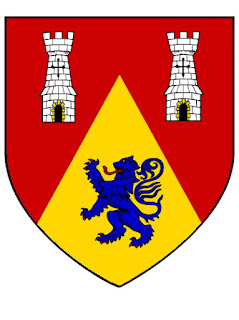Not only does this fine back-street local have the best-kept beer in Cambridge (in my not at all humble opinion), it also has a most interesting two-sided signboard:
 |
| Live & Let Live, north-facing side of signboard |
The signature and date reveal that it was painted in 1987 by one G. Jones, and is a copy of the last known sign of a pub called The Man Loaded With Mischief, which once stood on Madingley Road. The original sign, painted by local artist and prolific inn sign painter Richard Hopkins Leach, now resides in the Museum of Cambridge (formerly the White Horse Inn) on Castle Street.
(Unfortunately it's presently fixed flat against the wall so there is no way of telling whther this also had a different design on the reverse.)
But what strange thing is depicted? Well, the theme is an old one, of a miserable-looking man laden with a magpie (harbinger of misfortune), a monkey (think of the phrase ‘a monkey on your back’) and a gin-swilling wife. The most frequently cited source is a sign believed to have been painted for an inn of that name on Oxford Street, London, possibly by Hogarth:
This is clearly very closely related to a wonderful print published by Robert Sayer in 1766, entitled A Man Loaded with Mischief, Or Matrimony: A Monkey, a Magpie, and Wife; is the True Emblem of Strife. ‘Drawn by Experience; engraved by Design.’ The Library of Congress describes it thus:
“Print shows a man chained to wedlock carrying a woman on his back, her breasts exposed, she holds a cup labeled ‘gin’ and toasts ‘My Bucks Health’, and according to a pig in a pen, ‘She is as Drunk as David's Sow’; a monkey sits on the woman's lap, removing the man's wig, and a magpie sits on the monkey's shoulders. In the background is a building (probably a brothel) with horns mounted above a sign showing two cats and labeled ‘The Christian Mans Arms or the Cuckolds Fortune.’ Includes six lines of verse.”
The British Museum holds another, more rugged, take on the same theme, in a print from c.1750 to 1768, which bears a much closer resemblance to another said to date from 1752 than the perhaps more genteel images in which the lady is at least wearing a hat and is able to sit upright!
The artist John Crome also produced a version, so the image (or the sentiment it expressed) was clearly popular at the time.
There are some other examples, for example the Load of Mischief, Blewsbury. The Michief, Norwich also once had a version, but recently has gone for something less misogynistic (it's Political Correctness gone mad, I tell you!).
It even travelled across the Pond: in Philadelphia there is (or was) the Man Full of Trouble, dating from 1759.
The original seems to be an engraving in a book (scroll to p. 249) published in 1653 by Dutch poet and humorist, Jacob Cats.
Anyway, where better for such a poor, downtrodden bloke to find refuge from the causes of his burdensome strife than the pub?
The artist John Crome also produced a version, so the image (or the sentiment it expressed) was clearly popular at the time.
There are some other examples, for example the Load of Mischief, Blewsbury. The Michief, Norwich also once had a version, but recently has gone for something less misogynistic (it's Political Correctness gone mad, I tell you!).
It even travelled across the Pond: in Philadelphia there is (or was) the Man Full of Trouble, dating from 1759.
The original seems to be an engraving in a book (scroll to p. 249) published in 1653 by Dutch poet and humorist, Jacob Cats.
Anyway, where better for such a poor, downtrodden bloke to find refuge from the causes of his burdensome strife than the pub?










